Metamaterial Inspired Varactor-Tuned Antenna with Frequency Reconfigurability and Pattern Diversity
Abstract
:1. Introduction
2. Operating Mechanism of Dual Mode Antenna
2.1. CRLH-TL Based Annular Radiator with Broadside Radiation Pattern
2.2. Miniaturized SRR Loaded Circular Radiator with Omnidirectional Radiation Pattern
3. Fabrication and Measurement
3.1. Integration of the Proposed Dual-Mode Antenna
3.2. Varactors and DC Bias
4. Prototype Performance
5. MIMO System Analysis
5.1. 3-D Channel Model
5.2. Spectral Efficiency Analysis
6. Conclusions
Author Contributions
Funding
Institutional Review Board Statement
Informed Consent Statement
Data Availability Statement
Conflicts of Interest
References
- Sumana, L.; Sundarsingh, E.F.; Priyadharshini, S. Shape Memory Alloy-Based Frequency Reconfigurable Ultrawideband Antenna for Cognitive Radio Systems. IEEE Trans. Compon. Packag. Manuf. Technol. 2020, 11, 3–10. [Google Scholar] [CrossRef]
- Chu, H.; Guo, Y.-X. A Filtering Dual-Polarized Antenna Subarray Targeting for Base Stations in Millimeter-Wave 5G Wireless Communications. IEEE Trans. Compon. Packag. Manuf. Technol. 2017, 7, 964–973. [Google Scholar] [CrossRef]
- Aksimsek, S.; Ozek, E.A.; Ozpinar, H. Laser Ablation Cutting-Based Metal Patterning Technique Enabling 3D-Printed Broadband Antennas for Sub-6 GHz Wireless Communications Applications. IEEE Trans. Compon. Packag. Manuf. Technol. 2021, 11, 1506–1513. [Google Scholar] [CrossRef]
- Rao, Q.; Wilson, K. Design, Modeling, and Evaluation of a Multiband MIMO/Diversity Antenna System for Small Wireless Mobile Terminals. IEEE Trans. Compon. Packag. Manuf. Technol. 2010, 1, 410–419. [Google Scholar] [CrossRef]
- Cheng, Y.-F.; Cheng, K.-K.M. A Novel Dual-Band Decoupling and Matching Technique for Asymmetric Antenna Arrays. IEEE Trans. Microw. Theory Tech. 2018, 66, 2080–2089. [Google Scholar] [CrossRef]
- Zhang, N.; Hu, M.; Song, R.; Yuan, H.; Liu, N.; Guo, Q.; Yang, J. Fabrication of polymer@metal core–shell ±45° polarization diversity dipoles by mussel-inspired surface chemistry on 3-D printed objects. IEEE Trans. Compon. Packag. Manuf. Technol. 2021, 11, 892–898. [Google Scholar] [CrossRef]
- Oh, J.; Sarabandi, K. Compact, low profile, common aperture polarization, and pattern diversity antennas. IEEE Trans. Antennas Propag. 2014, 62, 569–576. [Google Scholar] [CrossRef]
- Yan, S.; Vandenbosch, G.A.E. Low-Profile Dual-Band Pattern Diversity Patch Antenna Based on Composite Right/Left-Handed Transmission Line. IEEE Trans. Antennas Propag. 2017, 65, 2808–2815. [Google Scholar] [CrossRef]
- Sun, L.; Zhang, G.-X.; Sun, B.-H.; Tang, W.-D.; Yuan, J.-P. A Single Patch Antenna with Broadside and Conical Radiation Patterns for 3G/4G Pattern Diversity. IEEE Antennas Wirel. Propag. Lett. 2015, 15, 433–436. [Google Scholar] [CrossRef]
- Hussain, R.; Khan, M.U.; Sharawi, M.S. An Integrated Dual MIMO Antenna System with Dual-Function GND-Plane Frequency-Agile Antenna. IEEE Antennas Wirel. Propag. Lett. 2017, 17, 142–145. [Google Scholar] [CrossRef]
- Alaa, A.M.; Ismail, M.H.; Tawfik, H. Random Aerial Beamforming for Underlay Cognitive Radio with Exposed Secondary Users. IEEE Trans. Veh. Technol. 2015, 65, 5364–5383. [Google Scholar] [CrossRef]
- Yousefbeiki, M.; Perruisseau-Carrier, J. Towards Compact and Frequency-Tunable Antenna Solutions for MIMO Transmission with a Single RF Chain. IEEE Trans. Antennas Propag. 2013, 62, 1065–1073. [Google Scholar] [CrossRef]
- Sammartino, P.F.; Baker, C.J.; Griffiths, H.D. Frequency diverse MIMO techniques for radar. IEEE Trans. Aerosp. Electron. Syst. 2013, 49, 201–222. [Google Scholar] [CrossRef]
- Selvam, Y.P.; Kanagasabai, M.; Alsath, M.G.N.; Velan, S.; Kingsly, S.; Subbaraj, S.; Rao, Y.V.R.; Srinivasan, R.; Varadhan, A.K.; Karuppiah, M. A Low-Profile Frequency- and Pattern-Reconfigurable Antenna. IEEE Antennas Wirel. Propag. Lett. 2017, 16, 3047–3050. [Google Scholar] [CrossRef]
- Chilukuri, S.; Rangaiah, Y.P.; Lokam, A.; Dahal, K. A Multi-Band Frequency and Pattern Reconfigurable Antenna for Wi-Fi/WiMAX and WLAN Applications: Frequency and Pattern Reconfigurable Antenna. In Proceedings of the 2018 9th International Conference on Mechanical and Aerospace Engineering (ICMAE), Budapest, Hungary, 10–13 July 2018; pp. 208–212. [Google Scholar]
- Zhao, Y.; Huang, C.; Qing, A.-Y.; Luo, X. A Frequency and Pattern Reconfigurable Antenna Array Based on Liquid Crystal Technology. IEEE Photon. J. 2017, 9, 1–7. [Google Scholar] [CrossRef]
- Fakharian, M.M.; Rezaei, P.; Orouji, A.A. A Multi-Reconfigurable CLL-Loaded Planar. Radioengineering 2020, 29, 313–320. [Google Scholar] [CrossRef]
- Rodrigo, D.; Cetiner, B.A.; Jofre, L. Frequency, Radiation Pattern and Polarization Reconfigurable Antenna Using a Parasitic Pixel Layer. IEEE Trans. Antennas Propag. 2014, 62, 3422–3427. [Google Scholar] [CrossRef]
- Shirazi, M.; Huang, J.; Li, T.; Gong, X. A Switchable-Frequency Slot-Ring Antenna Element for Designing a Reconfigurable Array. IEEE Antennas Wirel. Propag. Lett. 2017, 17, 229–233. [Google Scholar] [CrossRef]
- Pant, A.; Kumar, L.; Parihar, M.S. Electronically Pattern Reconfigurable Hexagon Shaped Loop Antenna. In Proceedings of the 2018 3rd International Conference for Convergence in Technology (I2CT), Pune, India, 6–8 April 2018; pp. 1–4. [Google Scholar]
- Nguyen-Trong, N.; Hall, L.; Fumeaux, C. A Frequency- and Pattern-Reconfigurable Center-Shorted Microstrip Antenna. IEEE Antennas Wirel. Propag. Lett. 2016, 15, 1955–1958. [Google Scholar] [CrossRef]
- Wu, C.-H.; Ma, T.-G. Pattern-Reconfigurable Self-Oscillating Active Integrated Antenna with Frequency Agility. IEEE Trans. Antennas Propag. 2014, 62, 5992–5999. [Google Scholar] [CrossRef]
- Kanjanasit, K.; Wang, C. A Wideband Resonant Cavity Antenna Assembled Using a Micromachined CPW-Fed Patch Source and a Two-Layer Metamaterial Superstrate. IEEE Trans. Compon. Packag. Manuf. Technol. 2018, 9, 1142–1150. [Google Scholar] [CrossRef]
- Zhang, J.; Yan, S.; Vandenbosch, G.A.E. Metamaterial-inspired dual-band frequency-reconfigurable antenna with pattern diversity. Electron. Lett. 2019, 55, 573–574. [Google Scholar] [CrossRef]
- Zhang, J.; Yan, S.; Vandenbosch, G.A.E. Realization of Dual-Band Pattern Diversity with a CRLH-TL-Inspired Reconfigurable Metamaterial. IEEE Trans. Antennas Propag. 2018, 66, 5130–5138. [Google Scholar] [CrossRef]
- Zhang, J.; Yan, S.; Vandenbosch, G.A.E. A Low-Profile Frequency Reconfigurable Antenna with Polarization and Pattern Diversity. In Proceedings of the 2019 IEEE MTT-S International Conference on Microwaves for Intelligent Mobility (ICMIM), Detroit, MI, USA, 15–16 April 2019; pp. 1–4. [Google Scholar]
- Wang, C. Design, calculation, and measurement of a single resonant mode metamaterial absorber and its tunable performance. Opt. Mater. 2024, 148, 114810. [Google Scholar] [CrossRef]
- Khajeh-Khalili, F.; Honarvar, M.A.; Naser-Moghadasi, M.; Dolatshahi, M. High-gain, high-isolation, and wideband millimetre-wave closely spaced multiple-input multiple-output antenna with metamaterial wall and metamaterial superstrate for 5G applications. IET Microw. Antennas Propag. 2021, 15, 379–388. [Google Scholar] [CrossRef]
- Karimipour, M.R.; Naeimi, A.S.; Javadifar, N.; Nasrollahnejad, M.B. A proposal for an ultra-sensitive nano-displacement sensing system based on all-dielectric metamaterials with tunable ultra-sharp Fano resonance peaks. Opt. Quantum Electron. 2024, 56, 136. [Google Scholar] [CrossRef]
- Khajeh-Khalili, F.; Honarvar, M.A.; Naser-Moghadasi, M.; Dolatshahi, M. Gain enhancement and mutual coupling reduction of multiple-intput multiple-output antenna for millimeter-wave applications using two types of novel metamaterial structures. Int. J. RF Microw. Comput. Eng. 2020, 30, e22006. [Google Scholar] [CrossRef]
- Ali, M.Y.; Lalbakhsh, A.; Koziel, S.; Golunski, L.; Ahmed, F.; Asadnia, M. A Low-Profile 3-D Printable Metastructure for Performance Improvement of Aperture Antennas. Res. Sq. 2024. [Google Scholar] [CrossRef]
- Bemani, M.; Nikmehr, S. Nonradiating Arbitrary Dual-Band Equal and Unequal 1: 4 Series Power Dividers Based on CRLH-TL Structures. IEEE Trans. Ind. Electron. 2013, 61, 1223–1234. [Google Scholar] [CrossRef]
- Che, B.-J.; Jin, T.; Erni, D.; Meng, F.-Y.; Lyu, Y.-L.; Wu, Q. Electrically Controllable Composite Right/Left-Handed Leaky-Wave Antenna Using Liquid Crystals in PCB Technology. IEEE Trans. Compon. Packag. Manuf. Technol. 2017, 7, 1331–1342. [Google Scholar] [CrossRef]
- Loghmannia, P.; Kamyab, M.; Nikkhah, M.R.; Rezaiesarlak, R. Miniaturized Low-Cost Phased-Array Antenna Using SIW Slot Elements. IEEE Antennas Wirel. Propag. Lett. 2012, 11, 1434–1437. [Google Scholar] [CrossRef]
- Yu, A.; Yang, F.; Elsherbeni, A.Z. A dual band circularly polarized ring antenna based on composite right and left handed metamaterials. Prog. Electromagn. Res. 2008, 78, 73–81. [Google Scholar] [CrossRef]
- Yan, S.; Vandenbosch, G.A. Zeroth-order resonant circular patch antenna based on periodic structures. IET Microw. Antennas Propag. 2014, 8, 1432–1439. [Google Scholar] [CrossRef]
- Bahl, I.J. Lumped Elements for RF and Microwave Circuits; Artech House: Norwood, MA, USA, 2003. [Google Scholar]
- MACOM Technology Solutions, MGV125 Varactor Datasheet. Available online: https://cdn.macom.com/datasheets/MGV125-x%20Series.pdf (accessed on 13 March 2020).
- Infineon Technologies, BB857 Diode Datasheet. Available online: https://www.infineon.com/dgdl/Infineon-BB837_BB857SERIES-DS-v01_01-en.pdf?fileId=db3a304313d846880113d97339a9011a (accessed on 13 March 2020).
- Sariri, H.; Rahmani, Z.; Lalbakhsh, A.; Majidifar, S. Compact LPF Using T-shaped Resonator. Frequenz 2013, 67, 17–20. [Google Scholar] [CrossRef]
- Liang, Y.; Domier, C.W.; Luhmann, J.N.C. RF MEMS Extended Tuning Range Varactor and Varactor Based True Time Delay Line Design. PIERS Online 2008, 4, 433–436. [Google Scholar] [CrossRef]
- Nezhad, S.M.A.; Hassani, H.R. A Novel Triband E-Shaped Printed Monopole Antenna for MIMO Application. IEEE Antennas Wirel. Propag. Lett. 2010, 9, 576–579. [Google Scholar] [CrossRef]
- Vaughan, R.; Andersen, J. Antenna diversity in mobile communications. IEEE Trans. Veh. Technol. 1987, 36, 149–172. [Google Scholar] [CrossRef]
- Zheng, K.; Ou, S.; Yin, X. Massive MIMO Channel Models: A Survey. Int. J. Antennas Propag. 2014, 2014, 1–10. [Google Scholar] [CrossRef]
- Chen, X.; Pei, H.; Li, M.; Huang, H.; Ren, Q.; Wu, Q.; Zhang, A.; Kishk, A.A. Revisit to Mutual Coupling Effects on Multi-Antenna Systems. J. Commun. Inf. Netw. 2020, 5, 411–422. [Google Scholar] [CrossRef]

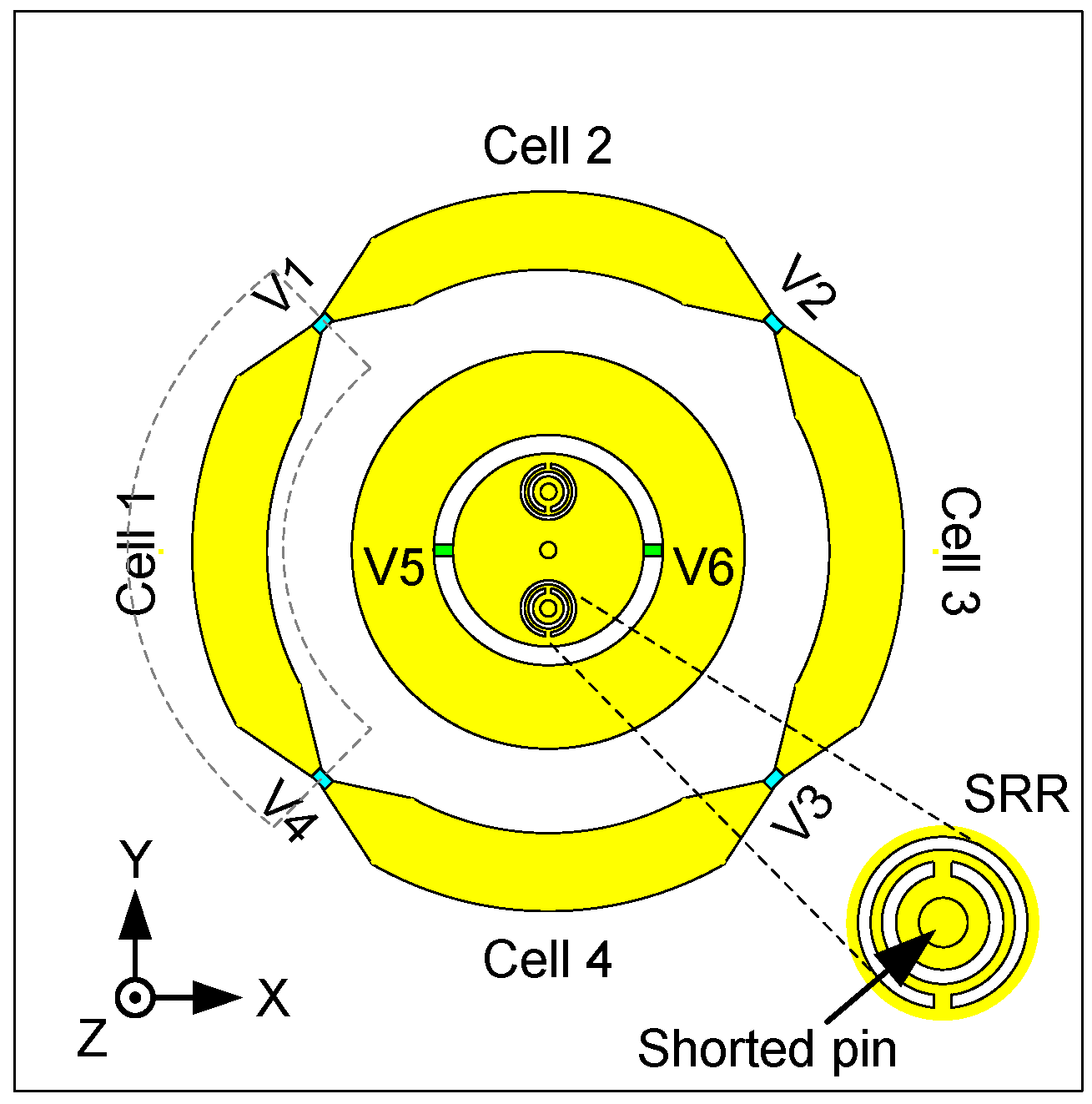
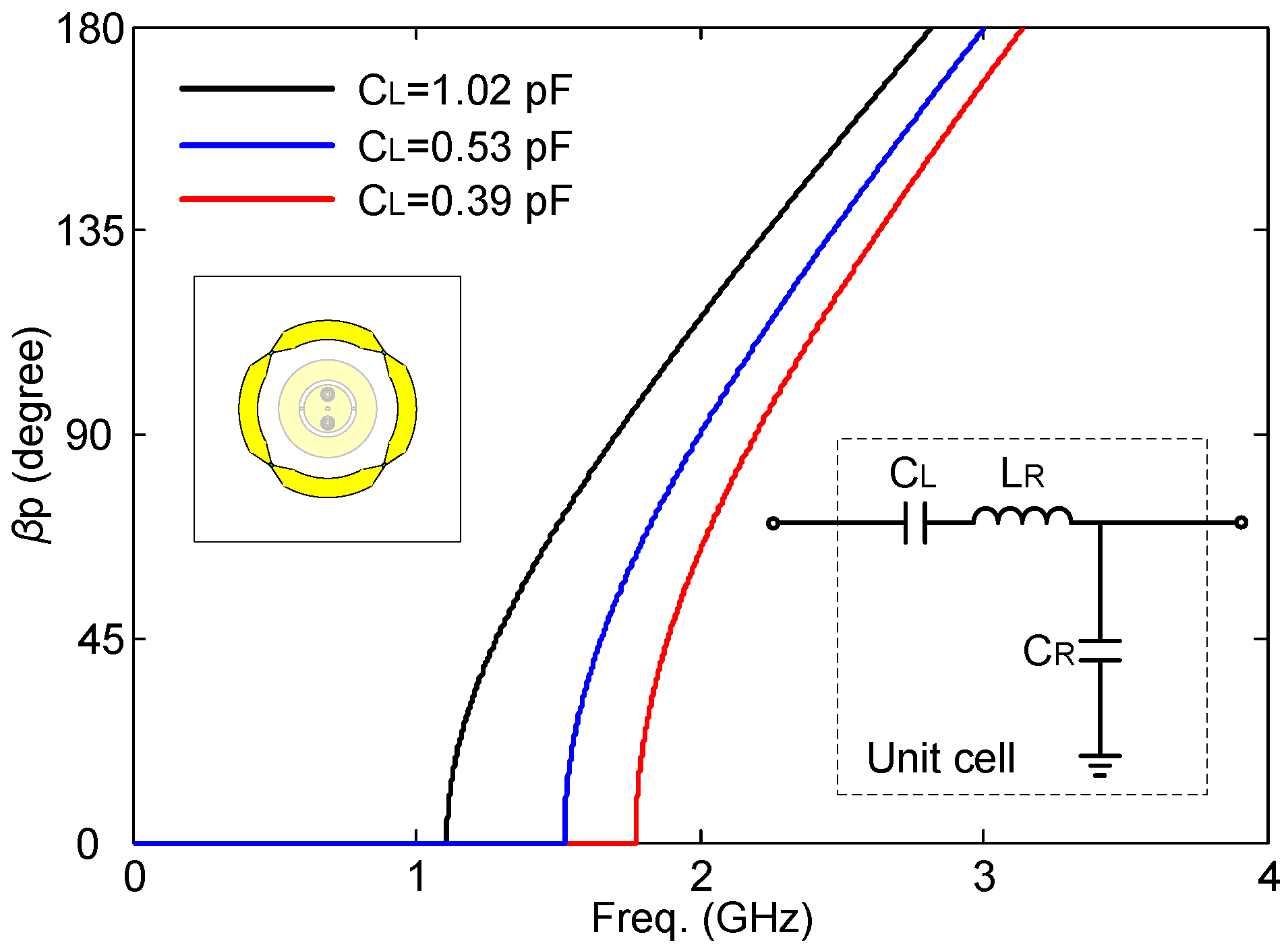

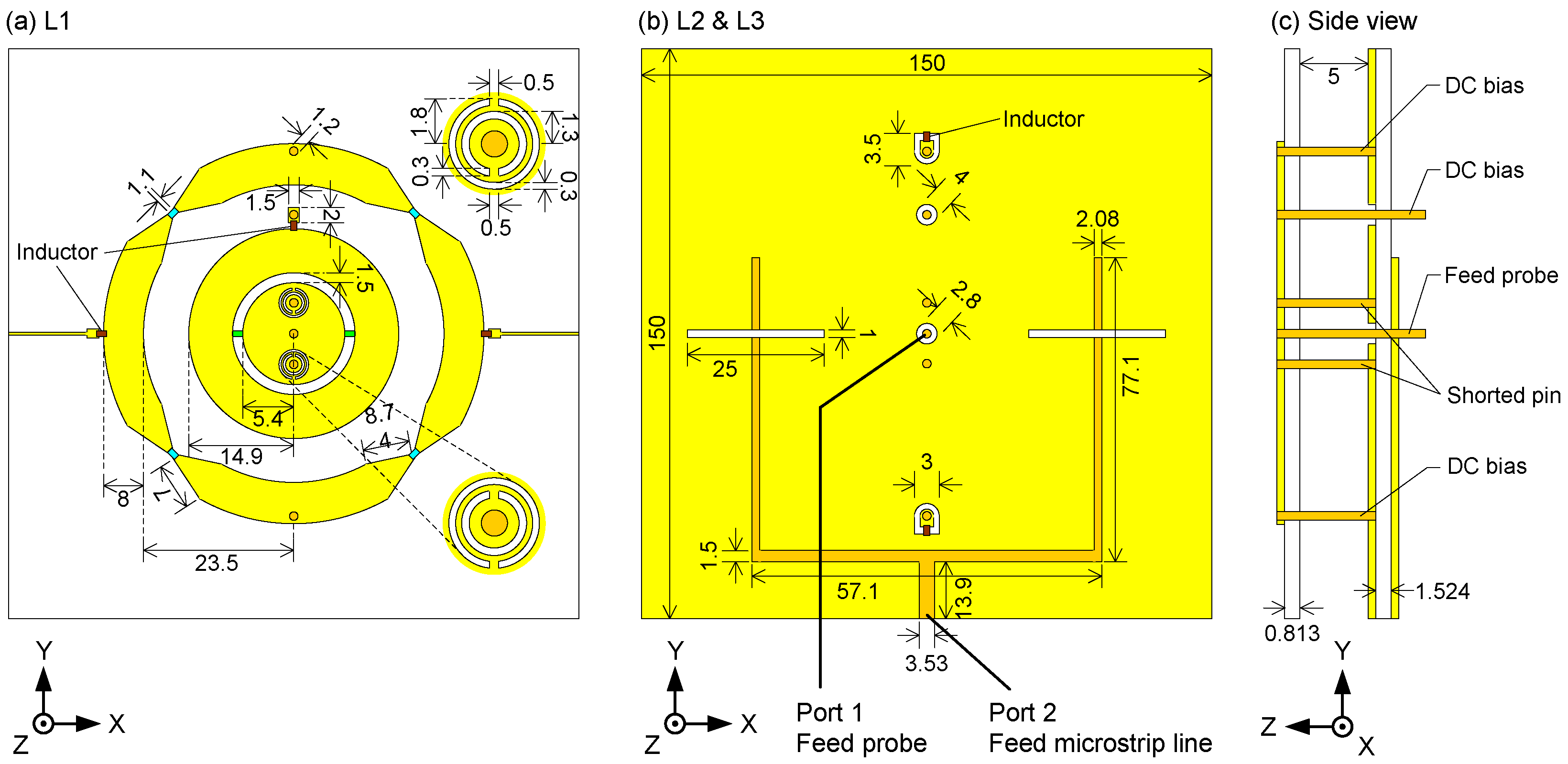



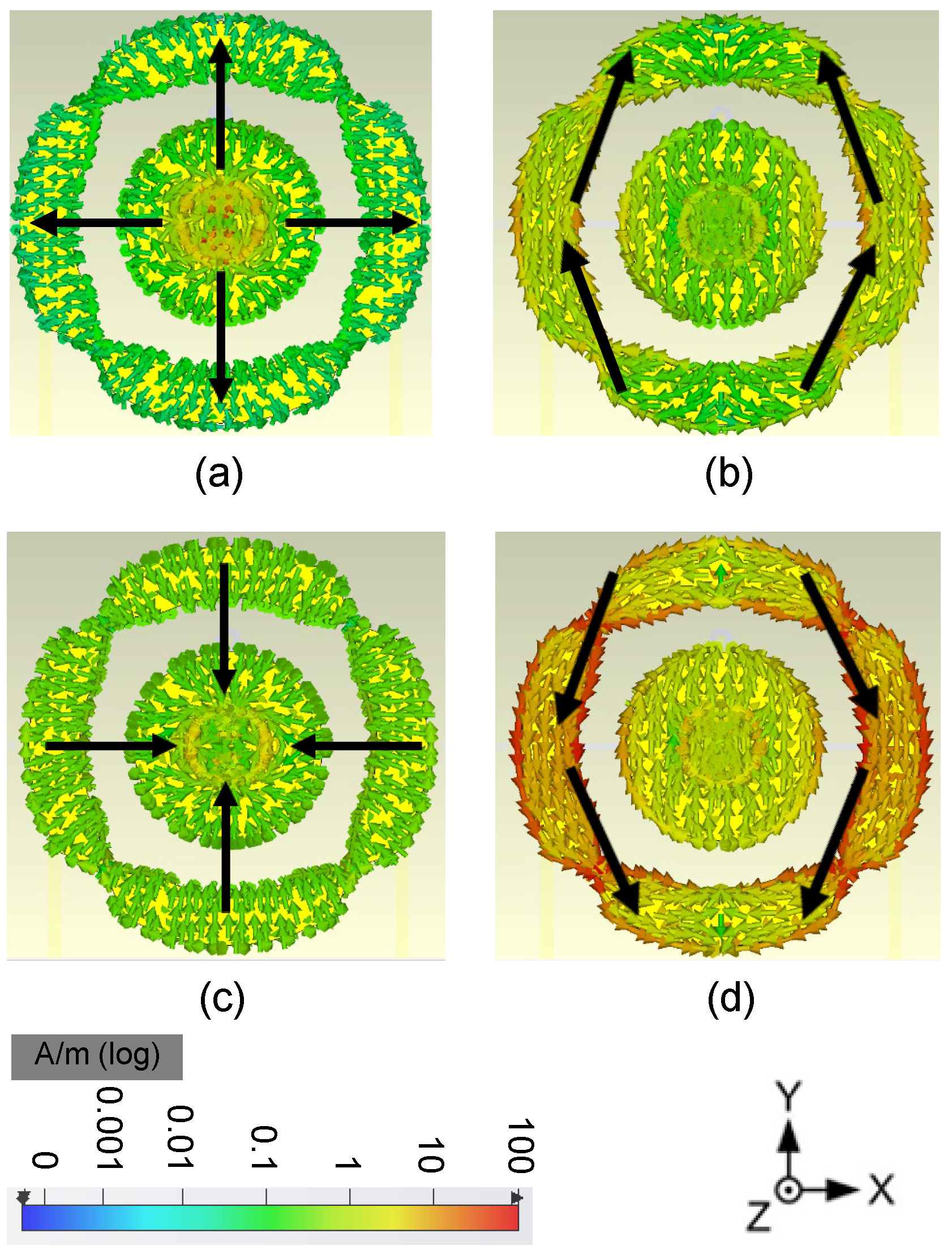

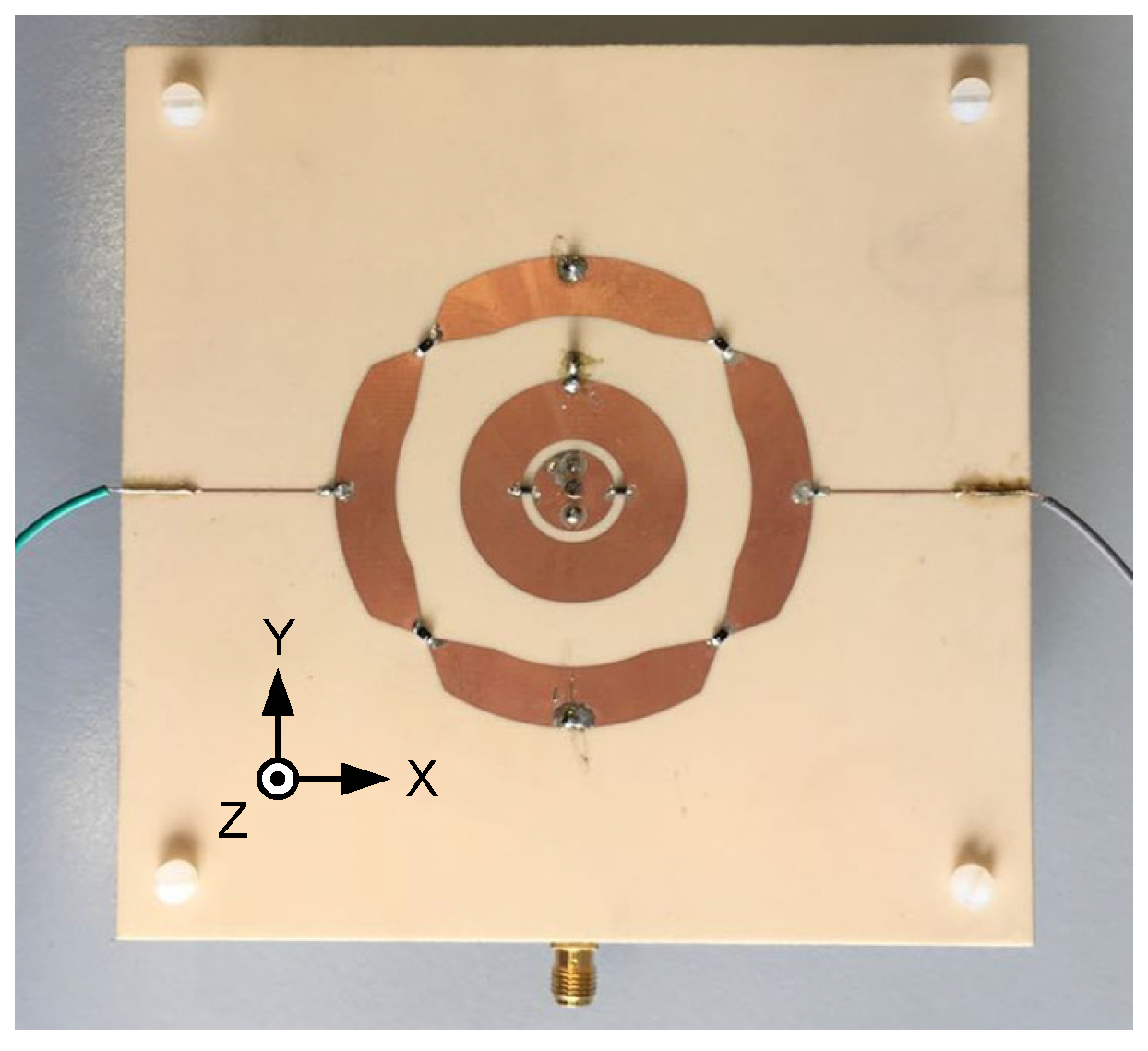
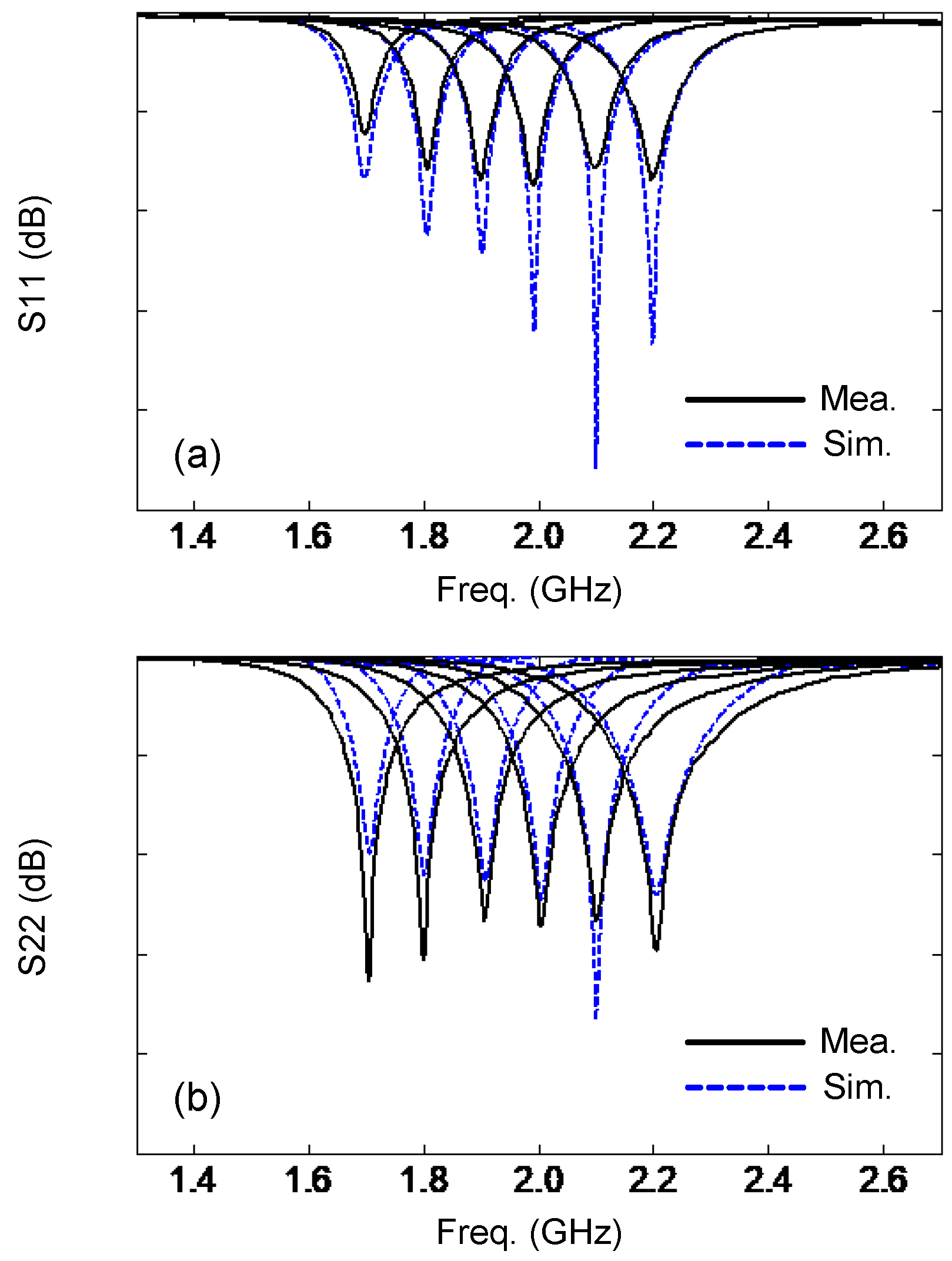
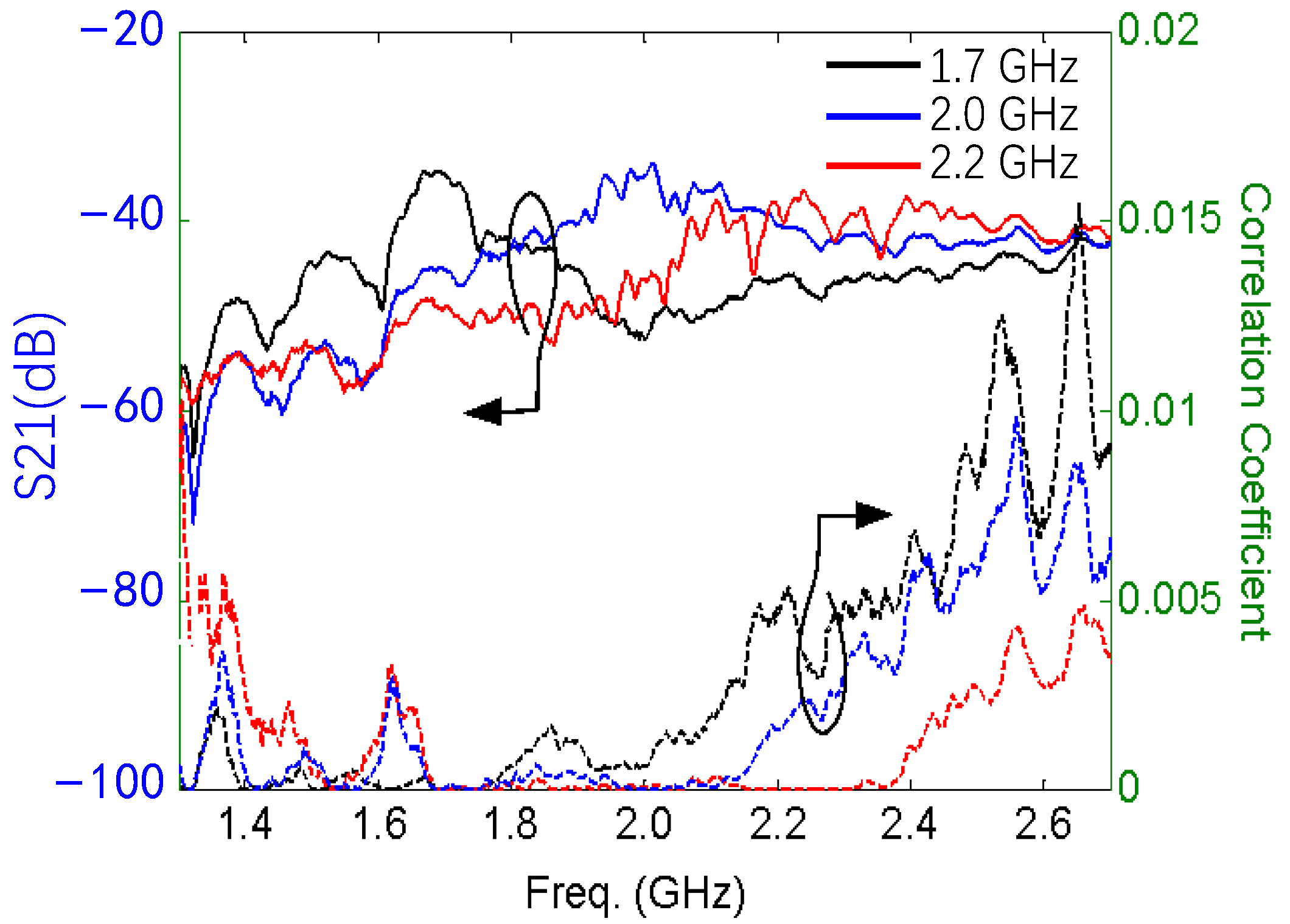

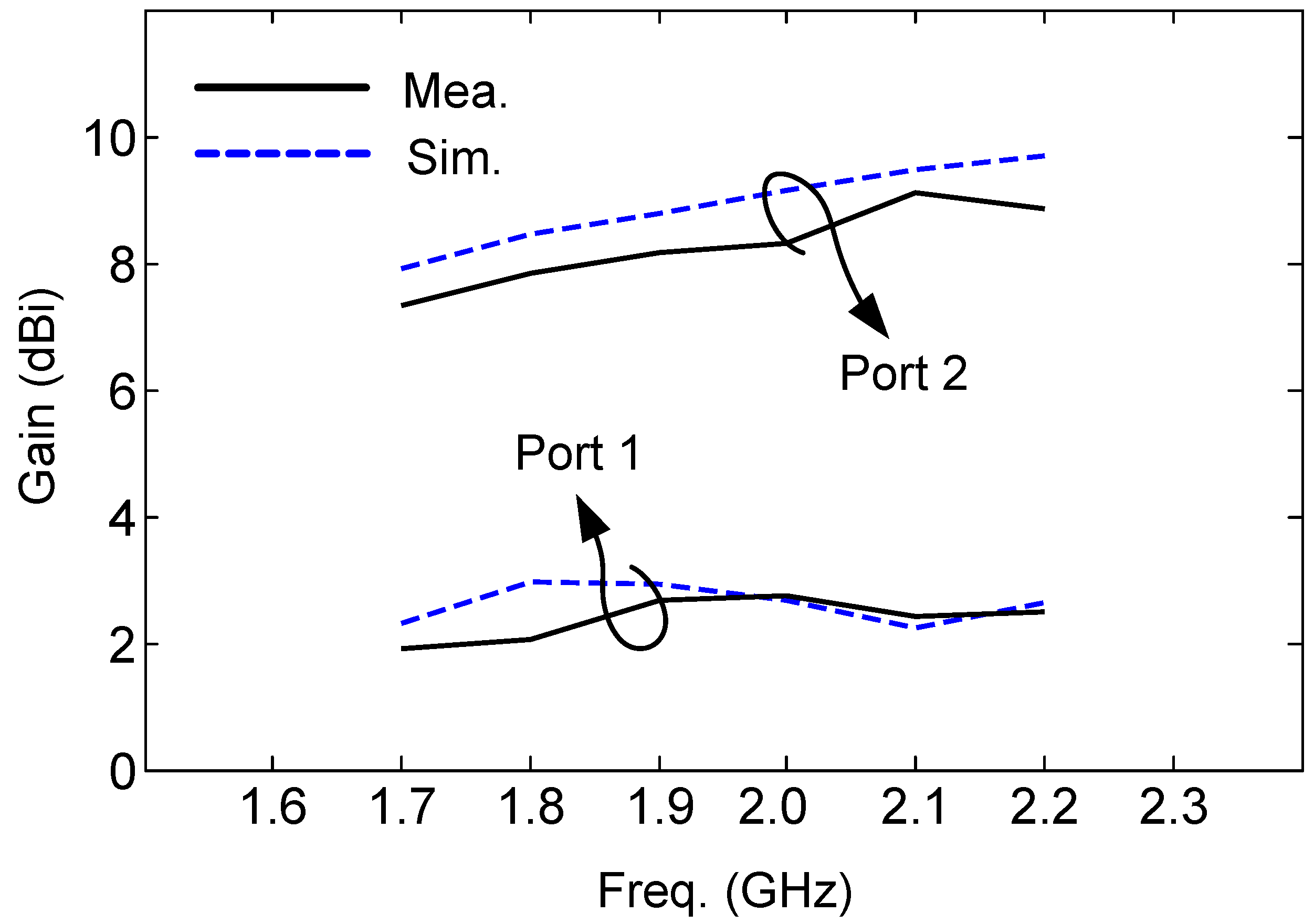
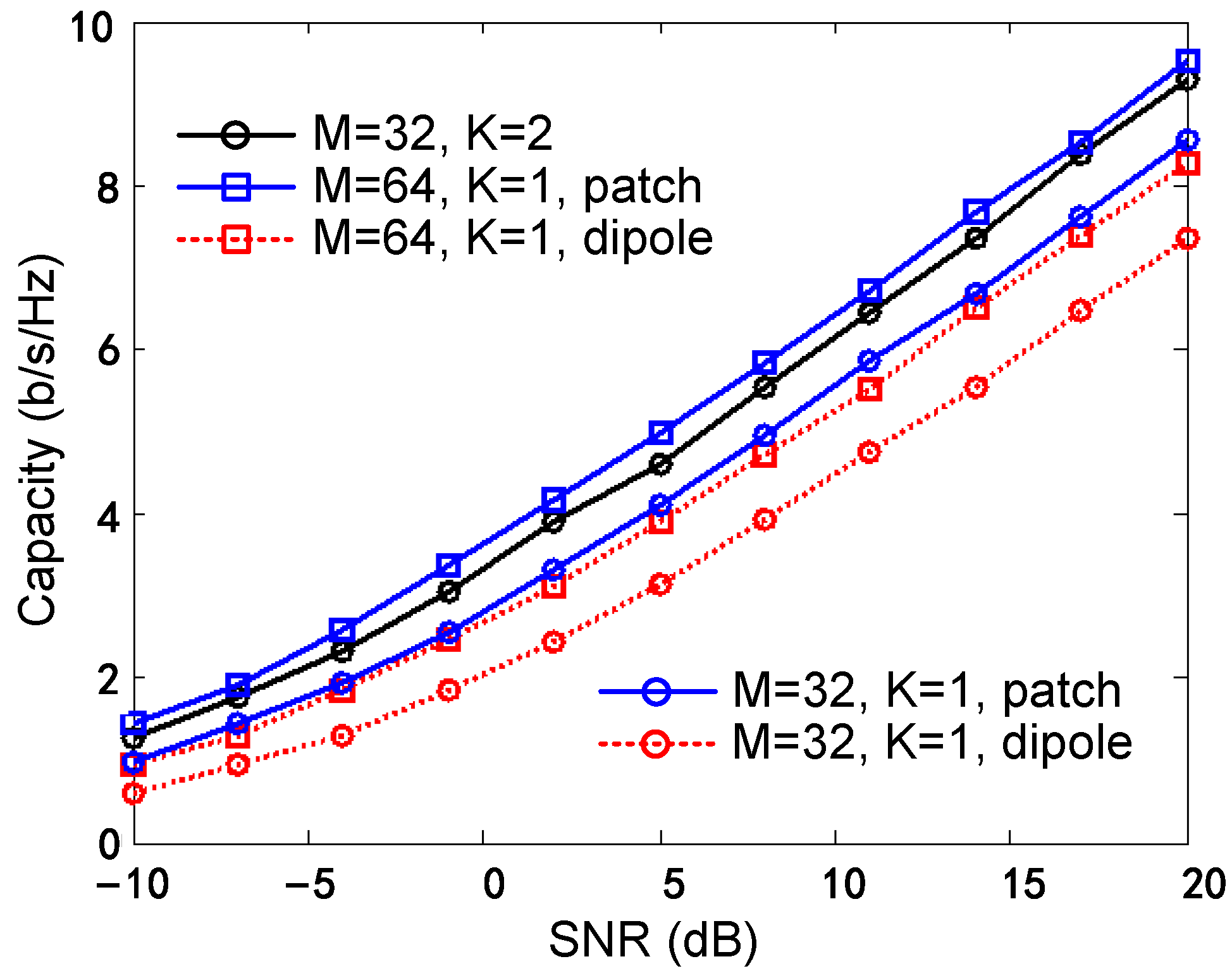
| Parameter | Value | Parameter | Value |
|---|---|---|---|
| CR | 1.80 pF | L1 | 0.12 nH |
| LR | 20.6 nH | L2 | 3.15 nH |
| C1 | 0.33 pF | L3 | 0.19 nH |
| C2 | 2.53 pF | Rrad | 38.91 Ω |
| Freq. (GHz) | Port 1 (pF) | Port 2 (pF) | ||
|---|---|---|---|---|
| Sim. | Mea. | Sim. | Mea. | |
| 1.7 | 4.02 | 6.6 | 1.03 | 1.1 |
| 1.8 | 2.51 | 3.9 | 0.705 | 0.68 |
| 1.9 | 1.33 | 1.9 | 0.528 | 0.49 |
| 2.0 | 1.02 | 1.2 | 0.403 | 0.38 |
| 2.1 | 0.865 | 0.9 | 0.315 | 0.29 |
| 2.2 | 0.725 | 0.8 | 0.244 | 0.25 |
| Ref | Antenna Type | Freq. Tuning Range | Antenna Pattern | Reconfiguration Method | |
|---|---|---|---|---|---|
| in GHz | in % | ||||
| [15] | CPW slot | 2.13–2.47 | 14.7% | Beam steering | 15 PIN diodes |
| [16] | Patch array | 14.5–16.4 | 3% | Beam steering | Liquid Crystal Tech. |
| [17] | monopole | 1.59–1.72 | 7.9% | Beam steering | 2 switchable loops |
| [18] | Patch antenna | 2.4–3 | 22.2% | Beam steering | 60 PIN diodes |
| [19] | Slot ring array | 1.68–1.83/ 5.05–6.37 | 8.6%/11.5% | Broadside | 16 PIN diodes |
| [20] | Alford loop microstrip antenna | 2.33-2.58 | 10.4% | Beam steering | 3 PIN diodes |
| [21] | Microstrip antenna | 2.7–3.3 | 20% | Broadside/Omnidirectional | 6 Varactors |
| [22] | Monopole/semi ring radiator | 4.27–4.94 | 14.5% | Omnidirectional end-fire | 2 PIN diode/1 Varactors |
| This work | CRLH/circular antenna | 1.7–2.2 | 25.6% | Broadside/Omnidirectional | 6 Varactors |
Disclaimer/Publisher’s Note: The statements, opinions and data contained in all publications are solely those of the individual author(s) and contributor(s) and not of MDPI and/or the editor(s). MDPI and/or the editor(s) disclaim responsibility for any injury to people or property resulting from any ideas, methods, instructions or products referred to in the content. |
© 2024 by the authors. Licensee MDPI, Basel, Switzerland. This article is an open access article distributed under the terms and conditions of the Creative Commons Attribution (CC BY) license (https://creativecommons.org/licenses/by/4.0/).
Share and Cite
Zhang, J.; Wang, B.; Yan, S.; Li, W.; Vandenbosch, G.A.E. Metamaterial Inspired Varactor-Tuned Antenna with Frequency Reconfigurability and Pattern Diversity. Sensors 2024, 24, 1956. https://doi.org/10.3390/s24061956
Zhang J, Wang B, Yan S, Li W, Vandenbosch GAE. Metamaterial Inspired Varactor-Tuned Antenna with Frequency Reconfigurability and Pattern Diversity. Sensors. 2024; 24(6):1956. https://doi.org/10.3390/s24061956
Chicago/Turabian StyleZhang, Jiahao, Buyun Wang, Sen Yan, Wei Li, and Guy A. E. Vandenbosch. 2024. "Metamaterial Inspired Varactor-Tuned Antenna with Frequency Reconfigurability and Pattern Diversity" Sensors 24, no. 6: 1956. https://doi.org/10.3390/s24061956





